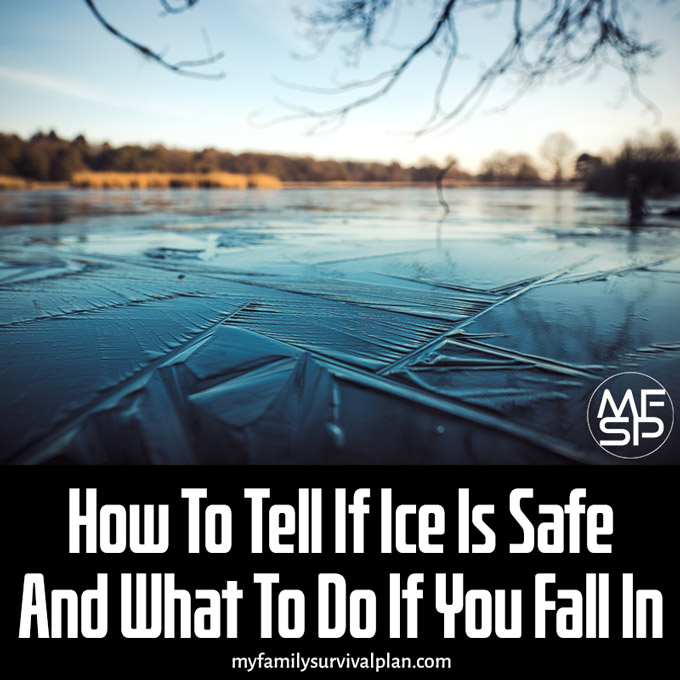Click Here To Join Our Telegram Channel for FREE daily tutorials!

How To Tell If Ice Is Safe And What To Do If You Fall In. Photo – Pixabay (PD)
Winter has settled in across the country, and many of the state parks are now blanketed with snow and ice. With summer temperatures still several months away, there is no better time to master the winter landscape. One particular feature of that landscape requires a bit of special attention and care: the ice. Since so many of our favorite winter activities, from ice fishing to snowshoeing to ice skating to snowmobiling, require venturing out onto the ice, practicing ice safety is essential.
If you’d like to explore the parks this winter without worrying about taking an unintentional Polar Bear Plunge, read on to learn how to tell if ice is safe.
1. Not all Ice is Created Equal
Wondering whether the ice is thick enough for your planned winter adventures? Well, that depends on what you’re planning to do. For example, ice that is thick enough for ice skating may not be thick enough for snowmobiling. Additionally, new, clear ice is about twice as strong as white or “snow” ice.
Here is a thickness chart to follow for new, clear ice:
 Image: www.ameriprisewomen.com
Image: www.ameriprisewomen.com
Keep in mind that if the ice is not new and clear, you will need to double the thickness amounts listed above.
2. How to Determine Ice Thickness
An ice thickness chart is really only handy when you know the ice thickness, which isn’t always measured and displayed for your convenience. That means that you, dear reader, may have to measure the ice yourself. While you may have a tape measure on hand (which you’ll need), first you’ll need a hole that you can measure. For that, you’ll need one of these tools specially designed for ice measuring:
Ice chisel – This metal rod has a flat, sharp blade welded onto one end. Use a stabbing motion to drive the chisel into the ice and create a hole.
Ice auger – There are 3 types of ice auger: electric-, gas- and hand-powered. Hand augers are prized for being quiet, lightweight and budget-friendly, although they require a bit more manual labor. Less manual labor is required for electric augers, which are also rather quiet. If you have a bit more money to spare, gas augers are the fastest at drilling through the ice. However, they are heavier and louder.
Cordless drill – Armed with a cordless drill and a long, 5/8″ wood auger bit, you’ll be able to drill through 8 inches of ice in under 30 seconds. Typically, any cordless drill that is at least 7.2 volts will work. However, a wood auger bit is a must, since they contain a spiral “flute” around the shaft lacking in metal drilling bits. The flute is necessary for pulling ice chips out of the hole and preventing the drill from getting stuck. Just be sure to dry the bit after each use and then spray it with silicone lubricant to keep it from rusting.
 Image: www.nickcobbing.co.uk
Image: www.nickcobbing.co.uk
Once you’ve created a hole in the ice, you’ll be able to put that tape measure to use. Dip the tape measure into the hole, and hook it under the edge of the ice. If you want to get really fancy, you can invest in an ice fisherman’s ice skimmer which has inch markings on the handle. However you want to determine the thickness, just make sure you’re actually measuring. It can be temping to judge ice thickness based on how easily you were able to break the surface, which often leads to overestimating. Always measure to be safe – and if in any doubt whatsoever, just don’t risk it.
3. Be Prepared With Proper Gear
Even if you faithfully abide by the ice thickness chart and carefully measure to determine exact ice thickness, accidents can happen. It’s best to be prepared for the worst because, as they say, you’re better safe than sorry.
Always wear a life vest under your winter gear (or a flotation snowmobile suit) when venturing out onto the ice by foot or non-enclosed vehicle. Falling into icy waters will present enough of a challenge even without worrying about staying afloat. Wearing a life vest, should you fall through, will allow you to focus all of your energy on getting out of the water safely.
 You can purchase ice picks or fashion them yourself if you’re feeling crafty.
You can purchase ice picks or fashion them yourself if you’re feeling crafty.
[Image: www.s124.photobucket.com]
Speaking of exiting the water, you should also carry a pair of ice picks with you. Whether you make them at home or purchase them at a sporting goods store, ice picks make the task of pulling yourself out of the water and onto the ice much, much easier.
Although the ice thickness chart above includes cars and trucks, you should avoid driving on ice whenever possible. If you must take your vehicle onto the ice, always keep your windows down so than you can easily escape should you fall through the ice.
4. What to Do if You Fall Through
Even the most stringent preparations can’t guarantee you won’t have an accident, so it’s essential to have a survival plan. The most essential factor of any survival plan is staying calm, which is much easier when you know what to do to get yourself out of harm’s way. Healthy adults have a window of 2-5 minutes to escape icy water before losing coordination and strength, so remaining calm will allow you to focus on using that time to get yourself to safety.
Should the worst case scenario happen, try not to panic and remember the following:
• Keep your winter clothing on. While it may seem that heavy clothes would drag you down, they actually can trap air, creating warmth and flotation.
• If you’ve sunk well below the surface, locate the hole by looking for contrasting color.
• Head back in the direction from which you came, which is probably where the strongest ice can be found.
• Use your ice picks for extra traction as you place your hands and arms on the solid surface of the ice. Get as much of your body out of the water as possible.
• Dig in your ice picks while you kick your feet and work yourself onto the unbroken ice.
 Image: www.wired.com
Image: www.wired.com
• Once you’re out, lie flat on the ice and roll away from the hole to keep your weight spread out and prevent you from breaking back through.
• Head back the way you came. Get yourself to a warm, dry area as soon as possible to begin re-warming yourself.
5. What to Do If You Can’t Get Out
In a perfect world, the above steps would get you to safety (actually, in a perfect world, you wouldn’t fall through the ice in the first place, but play along). Sometimes, though, it’s just not possible to pull yourself out of the water. If it doesn’t happen within 5-10 minutes, it probably isn’t going to. After that, you will lose strength, coordination and, eventually, consciousness.
However, that doesn’t mean you’re doomed. In fact, plenty of people who became unconscious after a fall through the ice have been rescued by keeping their heads above water. Even if you can’t fully exit the water, get as much of your body onto the ice as possible, since you lose heat much more quickly in water.
Once you’re as out as you’re going to get, stop struggling. Struggling zaps your energy and can lower your body temperature, which hastens hypothermia’s onset. Instead, spread your arms out against the ice, and don’t move them unless you begin to slip. This makes it possible for your body to freeze to the ice, which will keep you from sliding into the water once you lose consciousness, giving you more time to be rescued. Scary, but if you really can’t get out you just need to do whatever you can to maximize your survival chances.
 May your ice rescue be as successful and enjoyable as this one.
May your ice rescue be as successful and enjoyable as this one.
[Image: www.shrewsbury.net]
6. Should You Seek Medical Attention?
Yes. Even if you don’t feel like you need it, it is important to seek medical attention. Moderate to severe cases of cold water hypothermia require medical care, but because hypothermia takes some time to set it, you likely won’t be able to instantly determine your condition – especially if you’re numb! Additionally, the re-warming process can cause cold blood trapped in your extremities to rush back to your heart, the shock of which can cause a heart attack. Play it safe and get medical care as quickly as possible.
Have you survived a fall through the ice? Share your experiences – and your thoughts – below!
This Crazy Off Grid Device Literally Makes Drinkable Water From Fresh Air:
According to NASA, the U.S. is expecting a 100-YEAR LONG MEGADROUGHT.
It's already begun. Ask the farmers in California. They know.
Every survivalist knows that water is of critical importance. You NEED an independent water source that you can count on!
As an interesting "survival rehearsal" - imagine that you turned the tap on right now and nothing came out. How long would you last?
But what if there was another water source literally hidden in plain sight. That's right, I'm talking about the atmosphere!
The amazing thing about getting water from the natural moisture in the air... is that it is ALWAYS available.
This gives you real water security!
Learn more about how to tap into "Nature's secret water reservoir" and stay hydrated when TSHTF!
Watch the video:
😳 What Tinnitus Does To Your Brain Cells (And How To Stop It)
After 47 years of studies and countless brain scans done on more than 2,400 tinnitus patients, scientists at the MIT Institute found that in a shocking 96% of cases, tinnitus was actually shrinking their brain cells.
As it turns out, tinnitus and brain health are strongly linked.
Even more interesting: The reason why top army officials are not deaf after decades of hearing machine guns, bombs going off and helicopter noises…
Is because they are using something called "the wire method", a simple protocol inspired by a classified surgery on deaf people from the 1950s...

I Can't Help Showing This Off:
If you haven't heard of Claude Davis yet do yourself a huge favor and watch this video.
One of the smartest guys I ever had the pleasure of meeting, Claude set-up a unique prepping system that changed his life forever.
I already tried it myself and let me tell... you I was completely blown away... His surprising tactics could make your life easier and give you the peace of mind you deserve.
Don't just take my word for it... watch his short video and decide for yourself.

Most People Don't Have The Guts To Try This:
An amazing discovery in an abandoned house in Austin, Texas: A lost book of amazing survival knowledge, believed to have been long vanished to history, has been found in a dusty drawer in the house which belonged to a guy named Claude Davis.
Remember... back in those days, there was no electricity... no refrigerators... no law enforcement... and certainly no grocery store or supermarkets... Some of these exceptional skills are hundreds of years of old and they were learned the hard way by the early pioneers.
>> Click here to find out about them now
We've lost to history so much survival knowledge that we've become clueless compared to what our great grandfathers did or built on a daily basis to sustain their families.
Neighbors said that for the last couple of years Claude has tried to unearth and learn the forgotten ways of our great-grandparents and claimed to have found a secret of gargantuan proportions. A secret that he is about to reveal together with 3 old teachings that will change everything you think you know about preparedness:
>>> Click Here To Watch His Short Video <<<

More Off-Grid And Survival Resources:

What REALLY Happens When You Bury a Shipping Container? (Hint: It's A Bit Crazy...)
Shipping containers are all the rage - but if you are thinking about buying one, you MUST watch this video first:
There's a general belief that if you bury a shipping container you can create an awesome root cellar / storm shelter / survival bunker.
But is a shipping container strong enough to handle the pressure?
Watch the video to see what happens:
What Really Happens When You Bury a Shipping Container? (Click To Watch Video)










I’ll go along with “being better safe than sorry”. Where it concerns my grandkids, I really wouldn’t mind going through the ways and means to find out if the ice is thick enough and safe to ice skate on or to simply play on. Thanks for those practical ice tips on safety.